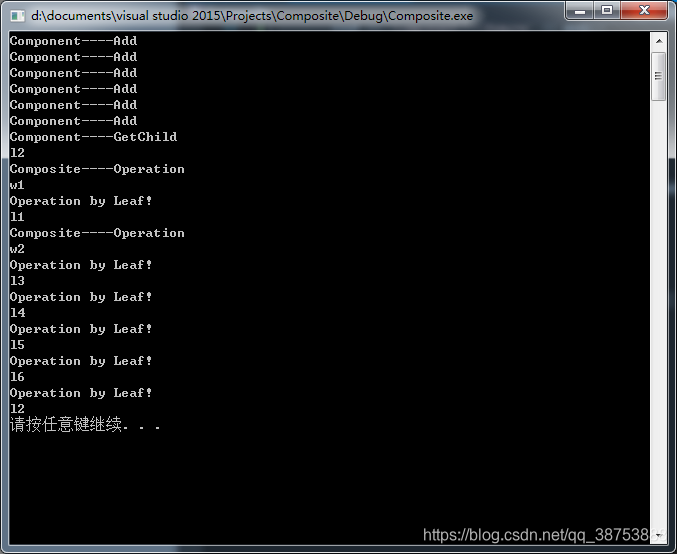#pragma once
#ifndef COMPOSITE_H
#define COMPOSITE_H
#include <iostream>
#include <list>
#include <algorithm>
#include <string>
using namespace std;
class Component
{
public:
Component() {}
virtual void Operation() = 0;
virtual void Add(Component* pChild) {}
virtual void Remove(Component* pChild) {}
virtual Component* GetChild(int nIndex) { return NULL; }
virtual void printname() {}
};
class Leaf :public Component
{
public:
Leaf(string name): m_name(name){}
virtual void Operation() { cout << "Operation by Leaf!" << endl; cout << m_name << endl;}
virtual void printname() { cout << m_name<< endl; }
private:
string m_name;
};
class Composite :public Component
{
public:
Composite(string name):m_name(name) {}
~Composite()
{
list<Component*>::iterator iterbegin, iterend, temp;
iterbegin = m_ListComponent.begin();
iterend = m_ListComponent.end();
while(iterbegin!= iterend)
{
temp = iterbegin;
delete(*temp);
iterbegin++;
}
}
virtual void Operation()
{
cout << "Composite----Operation" << endl;
cout << m_name << endl;
list<Component*>::iterator iterbegin, iterend;
iterbegin = m_ListComponent.begin();
iterend = m_ListComponent.end();
while (iterbegin != iterend)
{
(*iterbegin)->Operation();
iterbegin++;
}
}
virtual void Add(Component* pChild)
{
cout <<"Component----Add" << endl;
m_ListComponent.push_back(pChild);
}
virtual void Remove(Component* pChild)
{
cout << "Component----Remove" << endl;
m_ListComponent.remove(pChild);
}
virtual Component* GetChild(int nIndex)
{
cout << "Component----GetChild" << endl;
if (nIndex<=0 || nIndex>m_ListComponent.size())
{
return NULL;
}
list <Component*>::iterator iter = m_ListComponent.begin();
for (int i = 1;i<nIndex;i++)
{
iter++;
}
return *iter;
}
virtual void printname() { cout << m_name << endl; }
private:
list<Component*> m_ListComponent;
string m_name;
};
#endif // !COMPOSITE_H
#include "Composite.h"
#include <iostream>
#include <string>
using namespace std;
int main()
{
Composite* pRoot = new Composite("w1");
Leaf* pL1 = new Leaf("l1");
Leaf* pL2 = new Leaf("l2");
Leaf* pL3 = new Leaf("l3");
Leaf* pL4 = new Leaf("l4");
Leaf* pL5 = new Leaf("l5");
Leaf* pL6 = new Leaf("l6");
Composite* pC1 = new Composite("w2");
pRoot->Add(pL1);
pRoot->Add(pC1);
pRoot->Add(pL2);
pC1->Add(pL3);
pC1->Add(pL4);
pC1->Add(pL5);
pC1->Add(pL6);
pRoot->GetChild(3)->printname();
pRoot->Operation();
system("pause");
return 0;
}






 本文深入探讨了复合模式的设计与实现,通过C++代码详细解释了如何构建复合结构,使客户端能够一致地处理个体对象和组合对象。文章通过具体实例展示了如何使用复合模式来简化复杂的对象层次结构操作。
本文深入探讨了复合模式的设计与实现,通过C++代码详细解释了如何构建复合结构,使客户端能够一致地处理个体对象和组合对象。文章通过具体实例展示了如何使用复合模式来简化复杂的对象层次结构操作。
















 1712
1712

 被折叠的 条评论
为什么被折叠?
被折叠的 条评论
为什么被折叠?








